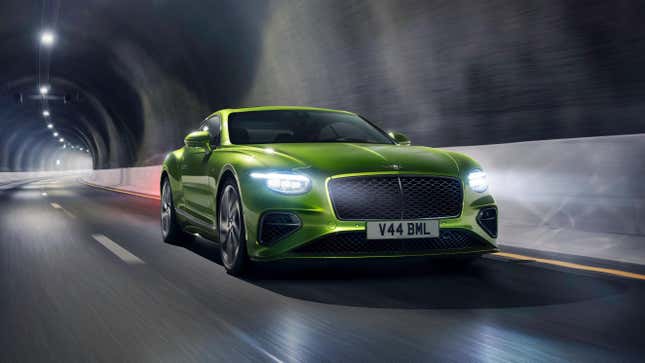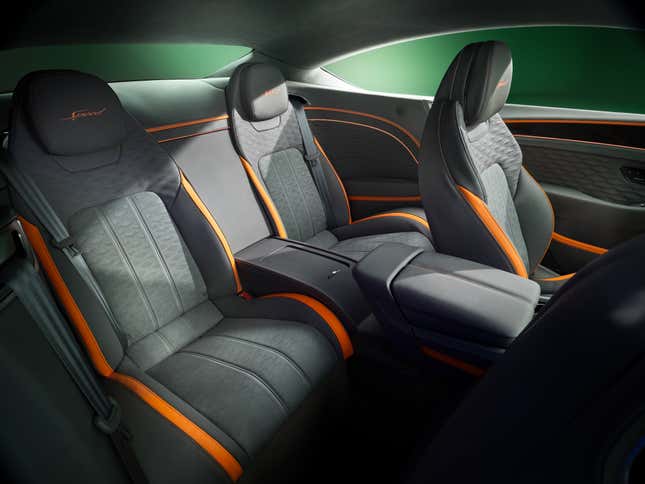After more than 20 years of producing its innovative W12, Bentley has retired the engine as the world moves towards hybrids and full EVs. Of course, the British brand still needs high-performance flagship trims in its lineup, so enter the new Continental GT Speed. Described as an “Ultra Performance Hybrid” by Bentley, the updated Speed has a plug-in-hybrid V8 setup that makes it the most powerful series-production Bentley of all time. Bentley is calling this the “fourth-generation” Continental GT Speed — it’s not, that’s silly. This is very obviously just a major refresh of the existing model, but that doesn’t take away from what a big deal the car is.
On its own, the Speed’s twin-turbo 4.0-liter V8 produces 592 horsepower and 590 pound-feet of torque, increases of 50 hp and 22 lb-ft over the V8 found in the V8 S model but 58 hp and 74 lb-ft shy of the old Speed’s W12. Augmenting the V8 and making up for the fewer cylinders is an electric motor mounted in the 8-speed dual-clutch transmission’s housing, which makes 187 hp and 332 lb-ft. Total system output is a mega 771 horsepower and 738 lb-ft, making the new Continental GT Speed a bit more powerful than the limited-run Batur. The 0-to-60-mph run takes just 3.1 seconds, four-tenths quicker than the old Speed, and the top speed is 208 mph, the same as the W12. (The convertible GTC Speed is two-tenths slower to 60, and its top speed is a mere 177 mph.)
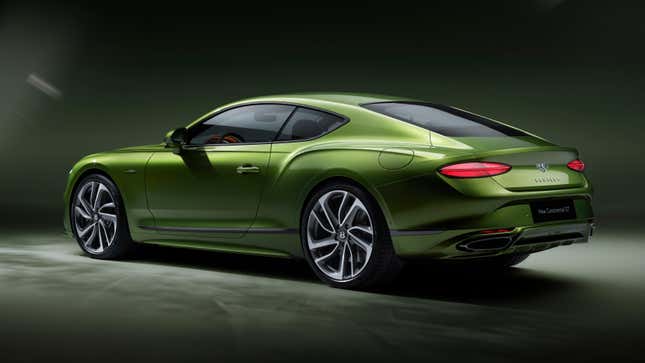
The electric motor provides torque-fill at low speeds and during gear shifts, and because it negates turbo lag Bentley was able to fit the engine with single-scroll turbochargers instead of the old V8’s dual-scroll ones, which can run hotter for fewer emissions. The single-scroll turbos are also less complex, and the engine doesn’t need cylinder deactivation hardware as the engine can be totally switched off when the car is being powered by the electric motor. Bentley says “a significant amount of development” went into making sure the exhaust sounds good without using artificial enhancement, too.
Mounted behind the rear axle is the 25.9-kWh battery pack; Bentley says its location helps give the car a near-perfect 49:51 weight distribution, versus 55:45 in the outgoing cars. Bentley claims an EV-only range of 50 miles on the European cycle, which should translate to around 40 miles on the EPA cycle. Top speed in electric mode is 87 mph, though if you go above 75 percent throttle application, the engine will kick in. In addition to the EV mode, the Speed has a mode that will charge the battery using the engine, and the car has regenerative braking, as well. With 11 kW of charging capability, the battery can be fully recharged in under three hours.
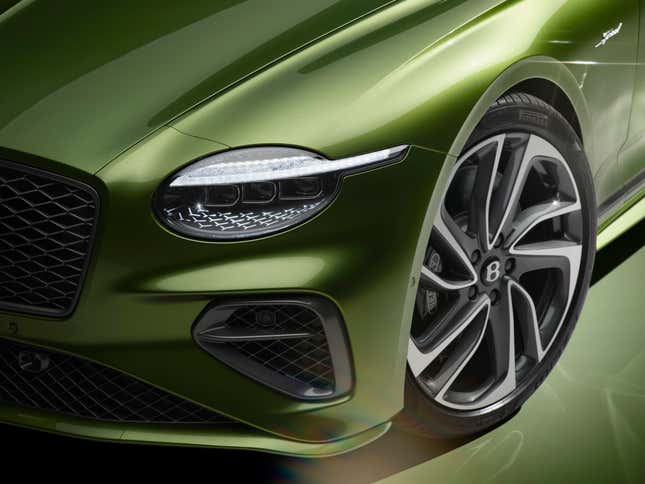
New for the Speed are dual-valve dampers with dual-chamber air springs, which Bentley says has a larger force spread between firm and soft, and the damper’s control ECU has “complete control” over independent compression and rebound damping. Other standard performance features include Bentley’s Dynamic Ride active anti-roll system, electronic limited-slip rear differential, rear-wheel steering, torque vectoring for both axles and new stability control software. In Dynamic mode, the stability control allows for more rear-end slip, and it can be completely turned off. Ventilated iron brakes are standard but larger carbon-ceramic discs are optional; both have 10-piston front calipers and 4-piston rears.
The new Continental GT is the first “mainstream” Bentley since the 1950s to have single headlights, which is pretty wild, and I think the car’s updated face looks really good. Its oval headlights feature an LED slash through them that forms an eyebrow-like shape, and the crystal-cut internals with 120 separate LEDs are as intricate as we’ve come to expect from Bentley. The grille mesh is a bit more complex, the front bumper intakes are more sculptural, and there are no more vents ahead of the doors on the front fender.
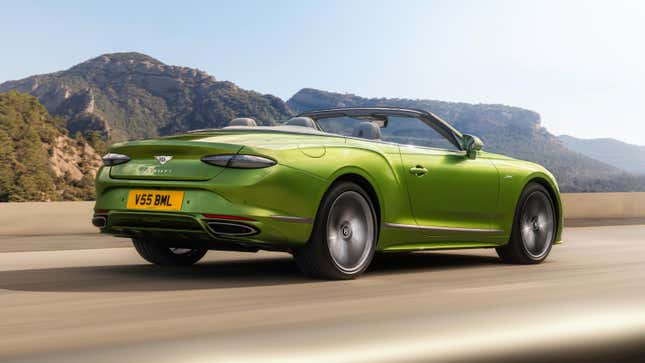
At the rear, the redesigned, wider taillights have a more pinched oval shape and protrude out from the trunk, with a “molten lava” visual effect from a new 3D diamond pattern. The trunk lid has an additional crease, and there’s no more active rear spoiler, with “an integrated aerodynamic form” providing enough downforce. The rear bumper is new, as well, with trapezoidal exhaust tips and a body-color diffuser. Other changes include new 22-inch wheel designs and new paint colors.
Interior changes are harder to spot, which is fine from a styling standpoint, as the Continental’s cabin remains one of the prettiest on the market. There’s a new “precision quilt” pattern with fading perforations, available dark chrome trim and Wellness seats with Postural Adjust and automatic climate functions. The ambient lighting now has 30 selectable colors, and the Rotating Display is still available, thank god. Three sound systems are offered, including the phenomenal 18-speaker Naim setup that has active bass transducers built into the seats, and there’s new laminated acoustic glass that reduces noise by nine decibels.
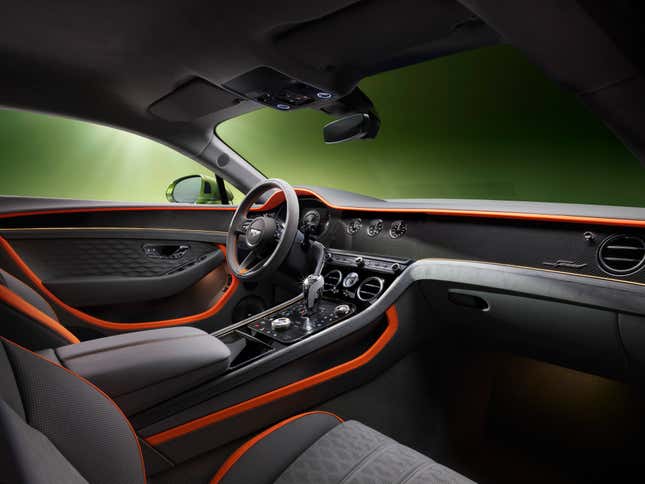
The GT Speed’s advanced hybrid powertrain was made possible by switching to a 400-volt electrical architecture, which also allowed for a major technology upgrade, including an overhauled infotainment system. Easier-to-use menus are paired with nicer graphics, both in the central touchscreen and the digital gauge cluster. Wireless Apple CarPlay and Android Auto are now available, and there’s a new My Bentley App Studio that will have a number of third-party apps for media streaming, gaming, parking and charging. Automatic parking assist is offered for the first time, with the car able to remotely park itself or be summoned by the driver’s phone, and green traffic light prediction is also new. The climate control has remote cabin pre-conditioning, new air ionizers and a particulate matter filter, and it uses navigation data to automatically improve cabin air quality.
Bentley has yet to say how much the new Continental GT Speed will cost, but don’t be surprised if it costs even more than the W12 Speed’s $300,000-ish base price when the PHEV model goes on sale in the third quarter of this year. It’ll be followed by a facelift for the rest of the Continental GT lineup, and its four-door Flying Spur sibling should receive the same PHEV Speed setup in short order.
